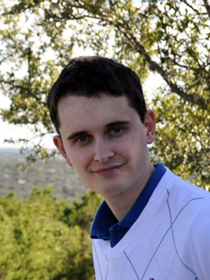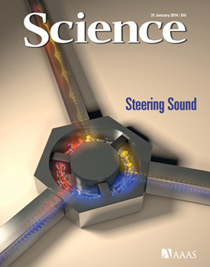Due to deep passion for physics, Romain Fleury, after completion of his engineering diploma in France, joined the research group of Prof. Andrea Alù at the University of Texas at Austin, where he is currently pursuing a Ph.D degree. His research focuses on metamaterials, a new branch of science and technology that is making its way to maturity.
To know and understand details about it and further more, let’s join our latest round of Q&A with the young and aspiring scientist – Mr. Romain Fleury:
Q. Let us start with your research topic. What is your research area? Will you please tell us a bit more on this? What did you find?
Romain Fleury: I am involved in cross-disciplinary research in the general area of wave physics and engineering. This includes electromagnetic and acoustic waves, but also other types of waves such as matter waves (the probability amplitude wave associated with a quantum particle). To be more specific, my current research mainly focuses on metamaterials, which are artificial materials that are structured and engineered to interact with waves in anomalous ways, and enable exotic physical phenomena that cannot be obtained with natural materials. For example, unlike naturally occurring materials, the refractive index of some metamaterials can take very extreme values, like zero, extremely large, or even negative. Of course, metamaterials are made of natural materials, with common properties, but it is the way we mix and structure these natural building blocks that give metamaterials their new, superior properties. Metamaterials have spectacular applications, like invisibility. Part of my research is focused on studying the potentials of metamaterials for cloaking applications.

Romain Fleury: The concept of metamaterials was initially formulated for electromagnetic waves, but now, we are starting to look beyond electromagnetism (Courtesy photo)
The concept of metamaterials was initially formulated for electromagnetic waves, but now, we are starting to look beyond electromagnetism. I believe that metamaterials can also have groundbreaking impact in the fields of acoustics, quantum electronics, mechanics and thermodynamics. One current research trend is to transpose an existing electromagnetic concept to one of these other fields, understand the differences and study the novel physics associated with it, and look for potential applications. For instance, I have studied artificial acoustic materials that have zero density, and shown how they could open new vistas in the field of energy concentration and harvesting. As other example, I have formulated a theory for quantum cloaking, enabling invisibility with regard to a flow of matter (like electrons), opening new possibilities in quantum electronics.
Recently, I have pioneered the field of linear non-reciprocal acoustics (see Science 343, pp.516-519 and the cover), building an acoustic circulator, a device that manipulates sound in novel ways with potential for use in various technologies from acoustic imaging to noise control. Circulators are well-known devices in the microwave community, where they are used in almost every wireless communication systems. Our circulator is the first-of-its kind for acoustic waves.
Q. Why is this important? (i.e. why should the general public care about this?)
Romain Fleury: Using this device, we have demonstrated that it is possible to create what we call an “acoustic isolator”, i.e. a communication channel in which waves can propagate in one direction, but are blocked in the other. It is basically a one-way road for sound, i.e. the equivalent of an electronic diode for the acoustic energy flow. If two people talk to each other through such a device, only one of them can hear the other. Because of this, our device may have considerable potentials in noise control, for houses near highways or airports, or in spying systems which would be the acoustic counterpart of a one-way mirror.
The applications in acoustic imaging, like medical ultrasonography or sonar systems, are equally promising. Indeed, in microwaves circuits, similar components are widely used in radars as duplexers to steer signals from the transmitter to the antenna and from the antenna to the receiver. They isolate receiver and transmitter and enable the use of a single antenna, considerably lowering the cost and the complexity of the system. I believe that our circulator could be used in a similar way in sonar systems, significantly reducing their cost and complexity.
Q. Is this truly new information or does it confirm what other researchers have found?

A circulator for sound. The arrows represent acoustic signals flowing through the device (diameter: ~20 centimeters), which circulates sound in a nonreciprocal fashion: Signals can flow from left to top, from top to right, and from right to left, but not in the opposite directions. This creates one-way communication channels for sound, allowing listeners to hear but not be heard in return. Image credit: Erik Zumalt, Cockrell School of Engineering, UT Austin.
Romain Fleury: Acoustic isolation has only been previously though and achieved using non-linear materials. The problem with non-linear materials is that they work only for very powerful sound signals, which is not compatible with the small signal usually encountered in linear acoustics. In addition, they completely distort the signal. This is problematic for any application which needs the signal to be preserved, like in imaging. in addition, they would block sound only for intensities above a certain threshold, and this threshold is too high for regular noise applications. Other researchers have proposed linear devices that have asymmetric transmission properties, but they cannot be used for isolation because they are reciprocal. In contrast, our non-reciprocal device is completely linear, distortion-free, and has the additional advantages to be subwavelength (i.e. very compact) and cheap.
Q. How did you land here. Was it your goal?
Romain Fleury: I am from France and attended engineering school in France until I obtained the national engineering diploma in 2010 (which is equivalent to a MS degree). I have always been passionate about physics and the applications it can have on people’s everyday life. After achieving my research internship at the Ecole Polytechnique Federale de Lausanne (EPFL), in Switzerland, I knew that I wanted to be a scientist and decided to pursue a Ph.D. I applied and was admitted as a graduate student in the Electrical and Computer Engineering department at the University of Texas at Austin in fall 2010, and quickly joined the group of Prof. Andrea Alù, where I have been a Ph.D. student since then. I truly enjoy working here as I get to experience all aspects of the job of professor and researcher : researching, teaching, peer-reviewing, connecting with companies, attending conferences and presenting, seeking funding, publishing, etc. My goal is to make an impact on people’s life by discovering new technologies and taking them to the market.
Q. How many hours a day you spend for study. How you arrange other side of your life like social activities so to say?
Romain Fleury: Now that I have finished to validate all my courses, I am only focused on research. I have to admit, I am so passionate about my work that I do not count my time, but I think I work around 50 hours a week on my research, sometimes more. We are such a great group of graduate students working in our lab that we still find time to go out together and have a good time.
Q. Are you satisfied with your results? What about your publications?
Romain Fleury: As a researcher, my goal is to create new science. As an engineer, it is to take that new science to the market. I think I have already started to approach these two goals. So far, I am pretty happy with my research output. I have currently more than a dozen peer-reviewed articles that are published or under review, and about the same for conference presentations. We have a provisional patent on the acoustic circulator and we are thinking about doing something with this technology to take it to the market.
Q. If you would not be at your current profession, what other options would you consider for your career?
Romain Fleury: Right now, I am a research assistant, and a soon-to-graduate Ph.D. student. When I graduate, my plan is to continue my academic career and look for a post-doc position. At the same time, the technology of metamaterials is maturing, and there will be more and more opportunities in the near future for R&D scientist opportunities in the industry. This is another potential and career path for me.
Thank You.
